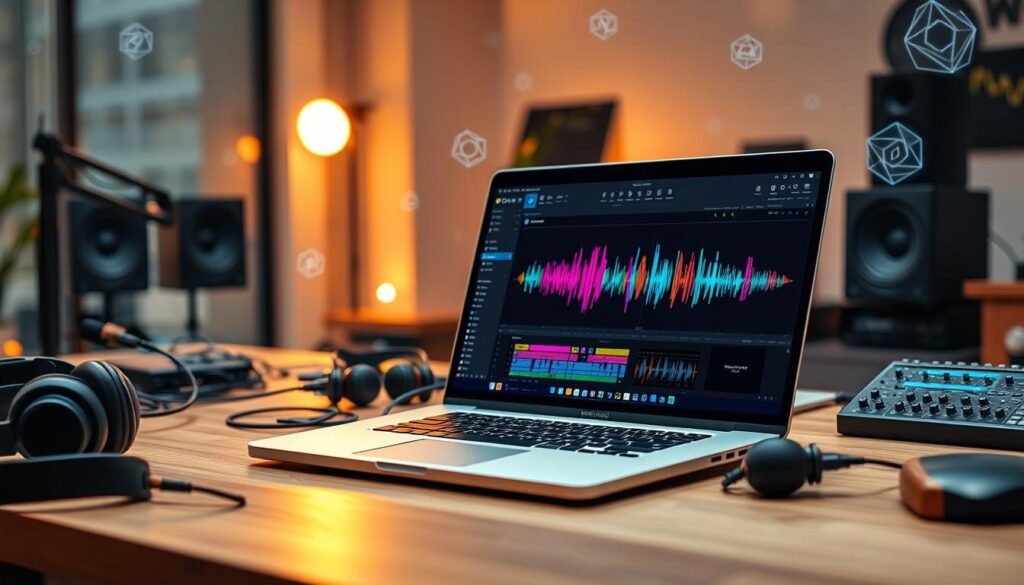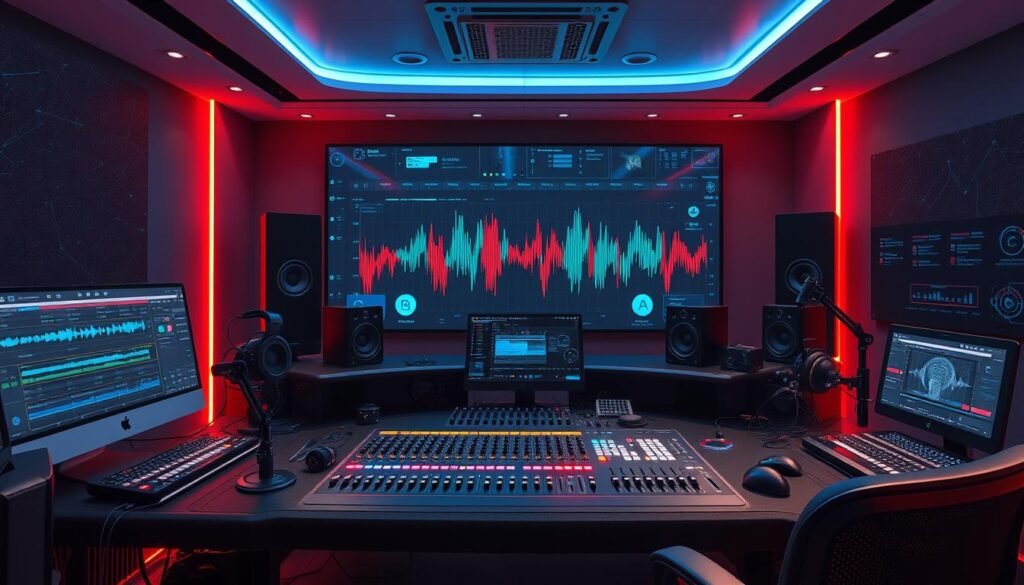Did you know that the Enhance Speech feature across Adobe products has nearly a million active monthly users? This shows how much people want easy-to-use audio editing AI tools. These tools make editing interviews, presentations, and lectures easier1. As more people create content for podcasts and music, knowing how to edit audio with AI can make your work better and faster.
Features like Filler Word Detection can save hours by removing unwanted speech1. Audiate also lets you work in many languages and instantly creates scripts2. Whether you're new to editing or a seasoned producer, AI tools can make your work much better.
Key Takeaways
- • Enhance Speech has nearly a million active monthly users demonstrating its effectiveness.
- • AI tools like Audiate simplify audio editing by removing filler words automatically.
- • Language detection features reduce manual input, streamlining the editing process.
- • AI can instantly generate scripts and provide customizable text-to-speech options.
- • AI-powered audio editors improve both audio quality and workflow efficiency.
Introduction to AI-Powered Audio Editing
The world of audio production is changing fast. Introduction to audio editing AI tools offers big benefits for creators. It makes it easier for anyone to make great audio, whether you're new or have a small business. AI does the hard work like cleaning up sounds and adjusting levels, saving you time and effort3.
AI voice generators are leading this change. They let you make voices for audiobooks, podcasts, and videos easily. You don't need a pro voice actor. Some tools even let you change the voice's pitch, speed, and emotion3. Wondercraft, for example, lets you make two podcast episodes every day, making it easier to create content4.
AI audio editors do more than just clean up recordings. They also fix sound levels and make the audio sound better. This makes making advanced audio easier and cheaper than going to a studio3. With AI, more people can explore the exciting world of audio editing.
Understanding Audio Editing AI Tools
Audio editing AI tools have grown a lot, making your audio projects easier. In 2024, six top AI tools for audio editing were highlighted. They show their special features and how easy they are to use5. These tools use artificial intelligence to do things like remove noise in real-time, making sounds clearer6.
AudioEnhancer.ai is a popular tool with prices starting at $10 a month for its Basic plan5. It has great features for improving audio quality. Descript also stands out, with a Hobbyist plan at $19 a month for advanced editing5.
Voice.ai is a free AI audio editing tool with a premium version for more features5. Adobe Audition, at $22.99 a month, is a top tool for professional editing5. Veed’s AI audio editor is also great, with features like volume control and noise removal5.

These tools use various techniques to improve audio quality. Actions like cutting and trimming are common in podcasts and music, making them clearer6. Fading in and out helps audio clips blend smoothly, keeping listeners interested6.
Equalization (EQ) lets users balance sound frequencies, making it sound better6. Dynamic range compression makes sounds more consistent, important for professional audio6. Effects like reverb and delay add depth and richness to audio6. Noise reduction techniques also remove unwanted sounds, making audio clearer and more satisfying6.
How to Edit Audio Files with AI Tools
Editing audio files is now easier with AI tools. These tools change how we edit audio, making it faster and better. You don't need to be a tech expert to use them. This lets you focus on your creativity while AI does the hard work.
Benefits of Using AI for Audio Editing
Using AI for audio editing brings many benefits:
- • Your editing process becomes smoother and quicker.
- • AI tools can quickly change audio files, like voices or remove echoes.
- • The tools have easy-to-use interfaces, giving you fast results.
- • They encourage you to try new things without worry.
Popular AI Audio Editing Tools
There are many AI audio editing tools to help you get great results:
| Tool Name | Notable Features |
|---|---|
| Voice.ai | Offers five free tools: Voice Changer, Vocal Remover, Echo Remover, Stem Splitter, and Key BPM Finder. The tools accept formats like mp3, wav, and more, emphasizing user-friendliness and efficiency7. |
| Riverside | Provides automated enhancement features that delete background noise, level audio, and improve recordings. It supports recording in resolutions up to 48kHz and transcription for over 100 languages8. |
| Otter.ai | Focuses on transcription but includes features for audio editing, making it suitable for podcasters and content creators. |

AI Audio Enhancement Techniques
In audio editing, AI tools are key. They make editing easier and improve sound quality. These tools use advanced algorithms for noise reduction and dynamic range compression. This ensures your audio sounds professional with little effort.
Noise Reduction and Cleanup
Noise reduction is crucial with AI audio tools. They remove background noise, making speech clearer. These tools use AI noise reduction algorithms to clean up recordings well.
With millions of content uploaded daily, quality matters. Poor audio can lose listeners. For podcasters and musicians, noise reduction boosts listener experience and engagement9.
Dynamic Range Compression
Dynamic range compression is vital. It keeps audio levels consistent. This prevents clipping and improves sound quality.
AI makes achieving high-quality audio fast. It's a favorite among content creators10. Tools like Auphonic and Descript offer advanced options. They ensure balanced sound, essential in today's audio world11.
| AI Tool | Features | Pricing |
|---|---|---|
| Auphonic | Noise reduction, dynamic range compression | Free 2-hour monthly plan; paid options from $12/month |
| Descript | Audio cleanup, transcription, dynamic range adjustments | Starting at $19/month |
| Adobe Podcast | Noise removal, voice enhancement, user-friendly dashboard | Free 30-day trial; Express Premium from $9.99/month |
| VEED.io | Background noise removal, loop audio, editing tools | Lite plan at $12/month; Pro plan at $24/month |
AI-Assisted Audio Production Features
AI-assisted audio production changes how we edit audio files. It makes the process more efficient and effective. Features like filler word detection and audio category tagging cut down on manual effort in audio editing.
Filler Word Detection and Removal
AI can now spot and remove filler words from spoken recordings. This feature makes editing smoother and your audio clearer. It saves time, especially in speech recordings where filler words are common.
Audio Category Tagging for Efficient Editing
AI-assisted audio production also includes audio category tagging. It sorts audio into types like dialogue, music, and sound effects. This smart tagging lets you use editing tools tailored to each audio type, making editing easier and more intuitive.

It's important to know how your privacy is protected when using these tools. Always check the privacy policy of the tools you use. For more information, visit this privacy policy page. This ensures your data is safe during and after your audio editing work12.
Automated Audio Processing
Automated audio processing is changing how we edit audio files. It uses AI algorithms in audio editing to make tasks easier. Tools like Media.io let you edit and convert over 20 sound formats, making your work faster and better13.
Removing audio distractions is key. The Filler Word Removal AI filter can get rid of over 20 interruptions at once14. This saves time and keeps your content interesting. Also, Descript offers cool features like eye contact correction and automated editing, opening up new creative options15.
AI tools can automatically fix audio issues like denoising and sound balancing. Media.io's AI noise reducer is a great example, removing unwanted sounds without losing quality13. Tools like Sonix can even turn audio into text with up to 99% accuracy, cutting down on transcription work15.
Using machine learning in audio editing makes enhancements smarter. For example, Adobe Premiere Pro's AI helps with editing, making video and audio production easier15. With the right tools, you can spend more time on creativity and less on technical editing.
Using AI for Audio Mastering
AI audio mastering has changed how musicians get their tracks ready for release. This new tech is loved by Grammy winners and over 5 million musicians worldwide16. It makes the mastering process easier, analyzing tracks and adjusting settings for top results16. You can get unlimited masters and make sure your album sounds great from start to finish16.
AI mastering is easy to use. Tools like Kits.AI let you master tracks with presets or even use YouTube tracks17. These tools save time and money, cutting out the need for expensive mastering engineers18. Now, musicians can make great-sounding audio without needing to know a lot of technical stuff18.
The world of AI audio mastering keeps getting better. LANDR, a leader in this area for over 10 years, offers free previews and formats like MP3 and WAV16. Thanks to better machine learning, these tools keep getting better, helping artists get the best sound18.
Practical Tips for Successful Audio Editing
Before you start recording, it's key to have a clear plan. This helps avoid a lot of editing later on. A good plan makes editing easier and leads to better results with AI.
Get to know tools like Audacity, GarageBand, and Adobe Audition. They make editing easier. For example, Audacity now uses AI for tasks like cleaning up noise and separating voices19. These tools help you do things like reduce noise and adjust sound levels, saving you time20.
Here's how to set up a good workflow:
- • Start by importing your audio and organizing it.
- • Then, remove any unwanted parts and improve the sound.
- • Make sure the volume is even and clear.
- • Use equalization and effects to enhance the audio.
- • Finally, check and refine your edits for the best result.
Using automation can save a lot of time. Editing a 30-minute podcast can take 1.5 to 2.5 hours. AI can make this process faster21. Also, try to record high-quality audio from the start. This makes editing easier and shows the value of good recording techniques.
Learn more about audio editing to get the most out of your tools. This way, you'll make better content faster and more efficiently.
By following these tips, you'll improve your audio production. You'll work more efficiently and create better content.
Conclusion
As we conclude, it's clear that AI tools have changed audio editing a lot. Tools like Beatoven.ai and Mubert make music creation easier and more accessible. They open doors for learning and creative projects, like podcasts and videos.
This is great for schools, where AI can help with tasks like making transcripts. It also makes creating dynamic content easier. This shows a big need for more AI audio tools22.
Looking ahead, AI in audio is set to change even more. Tools like MusicLM, AudioLM, and OpenAI’s Whisper will likely change how we make and use audio content22. Current tools, like Voxify and Fliki, already support many languages. This means AI audio can reach more people worldwide, changing how we edit audio in many fields23.
AI audio tools keep getting better, making editing easier and more creative. As more people use these tools, learning and making content will get even better. This is setting the stage for exciting changes in the future of AI in audio.



